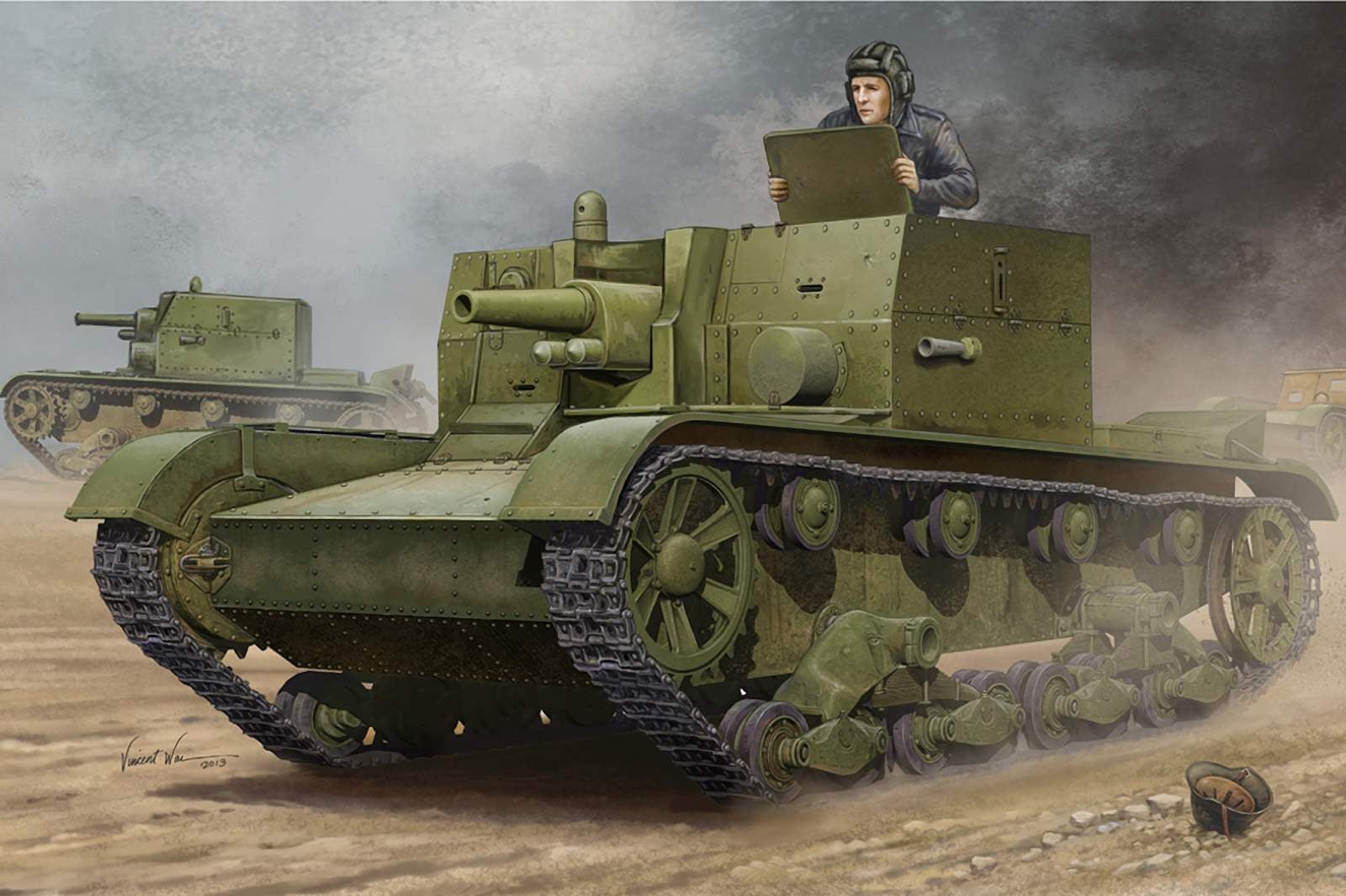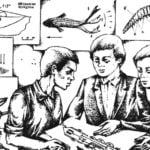 In July 1929 the revolutionary military Council of the USSR adopted the “System of tank-, tractor-, car-, breeveertien the red army” laid for the coming years program to create armored forces (from 1930 to 1933 – mechanized forces) the red Army. In the late 1920s and early 1930s, our industry started production of MS-1 tanks (T-18), which became the first production car T-24 from three-tier weapons, T-26. Developed prototype of the T-19 and T-20. It was a machine armed with a 37 mm Hotchkiss guns, PS-1, or even of 7.52-mm machine guns.
In July 1929 the revolutionary military Council of the USSR adopted the “System of tank-, tractor-, car-, breeveertien the red army” laid for the coming years program to create armored forces (from 1930 to 1933 – mechanized forces) the red Army. In the late 1920s and early 1930s, our industry started production of MS-1 tanks (T-18), which became the first production car T-24 from three-tier weapons, T-26. Developed prototype of the T-19 and T-20. It was a machine armed with a 37 mm Hotchkiss guns, PS-1, or even of 7.52-mm machine guns.
However, by this time, military experts agreed on the need to have the troops moving machine guns more substantial calibers. Tanks, armed with small-caliber guns, could not fight, for example, with gun emplacements of the enemy in any shelters. Was necessary maneuvering means being in the same ranks with the “linear” tanks, support them with fire. So in that period became an artillery tank, which attributed to a special class. It was believed that “modern artillery tank is booked fully or partially the tanks, the main weapon is a gun, usually larger calibre, mounted in a rotating turret, allowing for maneuver by fire during the brief fight.” Such machines could be fired on “targets detected, mainly from the place, with closed or open positions of the line of attack”.
The first prototype artillery tank was designed in KB of the office of mechanization and motorization of the red army (UMM RKKA) in early 1932 , he Created it on the basis of the tank BT-2, commercially manufactured in 1931 – 1933 . It was an easy krasnovostochnaya machine weighing 11.5 tons, armor thickness 6-13mm, which had a carbureted engine. It was set specially designed at the Izhora plant in Leningrad, Kolpino tower streamlined shape, which is placed protivosokovu 76.2-mm gun mod. Garford 1910, However, almost immediately it was replaced by the regimental gun mod. 1927 with a reduced length of rollback, but the same caliber. To the right of it put a 7.62 mm machine gun for firing on the infantry.

Tank Dyrenkova D-38

Dyrenkova artillery tank D-38, created on the basis of the tank BT-2. The initial sample with two 76.2-mm and 37-mm guns. 1932

Artillery tank at-1, designed on the chassis of tank T-26

The at-1. The weight of the tank is 9.5 tons, armament – 76.2 mm gun and 7.62-mm machine gun

The at-1. The view from the stern. Aft shields are felling completely closed
Test tank held in the spring of 1932, According to their results, the acceptance Committee only made a sobering conclusion, held that the installation of heavy guns on a tank is possible.
In the history of the tank this machine is known as tank D-38 designer N. Dyrenkova.
In 1934 at the Leningrad plant an experienced engineering No. 185 began to create another model artillery tank under the index at-1. The design was carried out under the direction of engineer P. Syachentov, a well-known designer tank guns. The first prototype was submitted for testing in April 1935
The basis for the creation of at-1 served as a light infantry tank T-26, taken into service in 1931, which had a weight of 9 tons and an engine capacity of 90 HP Constantly modernizirovannyi, he was first dvuhjadernym machine gun, then odnomestniy with a 37 mm cannon. By 1934 he was already armed with 45-mm cannon 20K, and set it in a cylindrical tower with feed burner.
The at-1 was a crazy machine with cabin, located on the chassis T-26 in its Central part. The cabin had a rectangular shape and was armored and defended the calculation of the cannon from the Armory of bullets. Her armor rolled sheets thickness 6 – 13 mm were connected with rivets.
When firing the side of the felling could be opened: to provide the best working conditions of the calculation view of the area and, of course, for removal of powder gases.

At-1:
1 – 76.2 mm gun PS-3; 2 – cutting; 3 – inlet; 4 – the directing wheel; 5 – basic cart with wheels; 6 – driving wheel; 7 – Luke loader; 8 – hatch commander’s; 9 – shutter engine compartment; 10-damper; 11 hatch engine compartment; 12 – the access hatch to the powertrain; 13 – 7.62-mm machine gun DT; 14 – driver’s hatch; 15 – hatch panoramas; 16 – headlights; 17 – and-aft shields are felling
For the at-1 P. Syachintovym developed a new semi-automatic gun high-power PS-3. It had a 76.2 mm caliber, rifled barrel with a length of 1640 mm or 21,5 klb.
A gun in the cockpit mounted on a pin pedestal in the rotating swivel. She could have given the angles of elevation from – 5° to +45°, with the horizontal guidance without rotation of the tank – up to 20° in both directions. Aiming was performed using panoramic and telescopic sights.
The weight of the gun was equal to 1350 kg, the maximum length of the rollback was 460 mm With the weight of armor-piercing projectile of about 6.5 kg, its initial speed was 530 m/s (with charge mass of 0.95 kg). The firing tests were shown with a range of 10 to 500 m (although the direct fire range was 500 m) at a rate of fire 10-12 RDS./min was Successfully carried out and shooting on the move.
In addition to guns, a tank armed with 7.62 mm machine gun, placing it right in front of the compartment in a ball bearing. Another of the same gun kept in the case.
The ammunition was 34 unitary shots (according to others – 40 or 41) and 1827 machine-gun rounds in 29 stores.
Note that the gun PS-3 was also determined on test samples of tanks T-28, T-29, T-35.
The crew was three people. The driver took workplace there is a compartment on the right, the commander, who is also the gunner, sat in the fighting compartment – in the cockpit – left of the gun, loader – right. For their entry and exit in the turret roof, had two hatches.
Suspension, transmission, 4-cylinder, 90-horsepower carbureted 90-horsepower engine was completely taken from T-26.

The at-1 was a crazy machine with the cutting of rectangular shape. When firing the side of the felling could partially recline

The at-1. View from the stern with open shields felling

Artillery tank at-1 in field tests. Winter 1935

Option under the artillery tank T-26-4 turret volume under 76.2 mm gun
Unfortunately, the results of field tests at-1 was not satisfactory as the work of cannon, and structural defects of the machine. The Commission noted insufficient the perfect semi-automatic guns, the unfortunate location of mechanisms aiming, no hillsoboro, the test machine was not allowed.
Meanwhile, experts of the Kirov factory (until 1934 “Red Putilovets”) proposed to replace the PS-3 for your gun, L-7, representing an enhanced 3-inch anti-aircraft gun Tarnavsky-Lender sample 1914/15 G. the Main difference from the predecessor was the presence of a vertical wedge semi-automatic breech. However, the gun had a too large size and it, at all desire, could not be placed in the wheelhouse at-1.
Then, in the same factory under the guidance of designer I. makhanova has created another gun, which received index L-10. The fundamental difference was the original wheel device.
This gun had a caliber of 76.2 mm, a barrel length of 23.7 klb, rate of fire 12 RDS./min Its armor-piercing projectile weighing 6.5 kg, which had an initial speed of 558 m/s, with a distance of 500 m could penetrate armour up to a thickness of 61 mm and at a distance of 1000 m – up to 50 mm. However, L-10 decided not to install the tank because of the closeness in the cockpit, and to increase it did not allow the dimensions of the machine itself.
All the military experts of the Armored Directorate of the red army in 1936 issued an order for the production of ten prototypes of the at-1 with a gun PS-3 for military trials. Production of hulls was placed at the Izhora plant, the chassis had to put the Leningrad plant No. 174 (1932 – State plant. K. E. Voroshilov) and is armed with a gun PS-3 Kirov factory.
SPECIFICATIONS TANK GUN PS-3, L-10

In 1937, Izhors fired eight corps, the Kirov workers have started assembling the first three machines. But then there was irreparable: head of design team at self-propelled artillery P. Syachentov was declared an “enemy of the people” and arrested. The projects on which he worked and his staff, have been preserved, including the covered and lapping artillery tank at-1.
Back to the topic at-1, as they say, on occasion. During the “Winter (Finnish) war” 1940 – 1941 very serious was the question of the evacuation of wounded soldiers from the battlefield. Then we remembered about the remaining factory No. 174 unsorted housings, and decided to turn them into sanitary tanks. One of them without any drawings, hastily altered, adapting to the transportation of the wounded. But to get to the front of the car did not have time because the end of the war.
Not so was the fate of the at-1 tank, which could become the first anti-tank self-propelled artillery.
TACTICAL AND TECHNICAL CHARACTERISTICS OF THE TANK D-38
Combat weight, kg……………………………11 500
Crew…………………………………………3
Length, mm……………………………………….5580
Width, mm……………………………………2230
Height, mm……………………………………..2400
Ground clearance, mm……………………………………..325
Weapons…………………..76,2-mm gun
7.62-mm machine gun DT Suspension …. 4 track roller on Board, drive sprocket rear
Transmission……………………mechanical,
four-speed transmission
Speed km/h:
on tracks……………………………………60
on wheels………………………………………..90
Cruising on the highway, km:
on tracks………………………………….120
on wheels………………………………………200
THE PERFORMANCE CHARACTERISTICS OF AN ARTILLERY TANK AT-1:
Combat weight, kg………………………………9550
Crew…………………………………………3
Length, mm……………………………………….4620
Width, mm……………………………………2445
Height, mm……………………………………..2032
Ground clearance, mm……………………………………..385
Reservations mm…………………………6-13
Weapons………….76,2-mm gun PS-3,
two 7.62-mm machine gun DT
Ammunition……………shots – 34 (41),
cartridges – 1827
Engine………………4-cylinder T-26
carbureted air-cooled power 90 HP at 2100 rpm
Transmission…………………….mechanical
4-speed, three gears forward, one back
Suspension……………..8 rollers
in 4 trucks, leaf springs, idler – front
Speed, km/hour:
on the highway………………………………………….30
the lane……………………………………..15
Tank capacity, l……………………………….192
Cruising range, km:
on the highway………………………………………..140
the lane……………………………………110
Specific power, HP/t…………………..10
Overcoming obstacles in m:
the height of the wall……………………………….0,70
the width of the pit……………………………………..2,0
fording depth……………………………….0,80
ascent, hail…………………………………….35
V. BORZENKO



